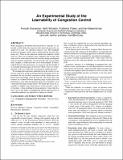An Experimental Study of the Learnability of Congestion Control
Author(s)
Sivaraman Kaushalram, Anirudh; Winstein, Keith; Thaker, Pratiksha R.; Balakrishnan, Hari
DownloadBalakrishnan_An Experimental Study.pdf (504.2Kb)
OPEN_ACCESS_POLICY
Open Access Policy
Creative Commons Attribution-Noncommercial-Share Alike
Terms of use
Metadata
Show full item recordAbstract
When designing a distributed network protocol, typically it is infeasible to fully define the target network where the protocol is intended to be used. It is therefore natural to ask: How faithfully do protocol designers really need to understand the networks they design for? What are the important signals that endpoints should listen to? How can researchers gain confidence that systems that work well on well-characterized test networks during development will also perform adequately on real networks that are inevitably more complex, or future networks yet to be developed? Is there a tradeoff between the performance of a protocol and the breadth of its intended operating range of networks? What is the cost of playing fairly with cross-traffic that is governed by another protocol? We examine these questions quantitatively in the context of congestion control, by using an automated protocol-design tool to approximate the best possible congestion-control scheme given imperfect prior knowledge about the network. We found only weak evidence of a tradeoff between operating range in link speeds and performance, even when the operating range was extended to cover a thousand-fold range of link speeds. We found that it may be acceptable to simplify some characteristics of the network—such as its topology—when modeling for design purposes. Some other features, such as the degree of multiplexing and the aggressiveness of contending endpoints, are important to capture in a model.
Date issued
2014-08Department
Massachusetts Institute of Technology. Computer Science and Artificial Intelligence Laboratory; Massachusetts Institute of Technology. Department of Electrical Engineering and Computer ScienceJournal
Proceedings of the 2014 ACM conference on SIGCOMM
Publisher
Association for Computing Machinery (ACM)
Citation
Sivaraman, Anirudh, Keith Winstein, Pratiksha Thanker, and Hari Balakrishnan. "An Experimental Study of the Learnability of Congestion Control." Proceedings of the 2014 ACM conference on SIGCOMM, August 17-22, 2014, Chicago, IL.
Version: Author's final manuscript
ISBN
978-1-4503-2836-4